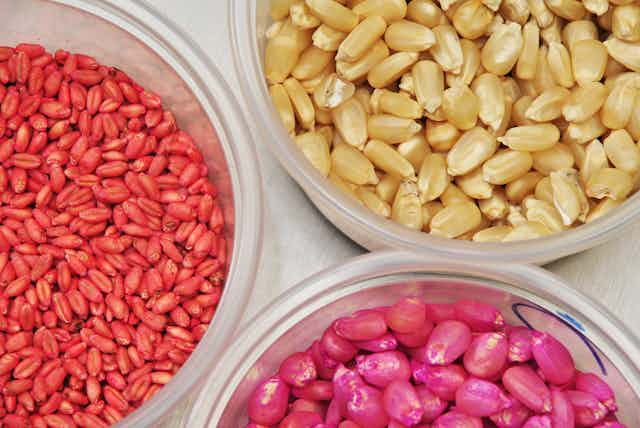Sex without seed. Seed without sex. It’s been said that the greatest gift of science to humankind would be achieving those two goals.
Effective contraceptives such as the pill have pretty much nailed the first goal.
Our findings, published on Friday in Science, could be significant pieces of the puzzle for the second.
That’s because by helping solve one of the fundamental questions in the evolution of plants, we may also have brought closer the possibility of cloning a plant with good traits through easy-to-distribute seeds, rather than cuttings.
This so-called “apomixis” is one of the holy grails of agriculture because it would make new crop varieties – ones that are resistant to drought, say – both cheaper, and more widely available.
What we — my post-doc Keiko Sakakibara and myself – have done is identify a molecular gate-keeper between the two life stages that make up plant life cycles.
Us and them
Plant life cycles are very different from our own.
The “us” we are most familiar with is complex and multicellular. Our body is composed of cells that are diploid, containing two copies of each chromosome. But we also have haploid cells, containing only one copy of each chromosome: the single-celled egg and sperm.
Those haploid cells are generated from special diploid cells via a process called meiosis; conversely, fertilisation – basically a union of two haploid cells – gives rise to the diploid us.

In contrast, plants alternate between haploid and diploid generations, both of which have complex multicellular bodies.
If this happened in us, it would be as if our sperm and eggs left our bodies, grew into multicellular organisms, went to the pub, met, and mated, eventually creating the next diploid generation.
So seemingly disconnected and dissimilar are the haploid and diploid bodies of many plants that for centuries they were sometimes mistaken for different species.
That changed in the mid-1800s with the findings of the incomparable German biologist and botanist Wilhelm Hofmeister. Making use of some recent technological innovation – better microscopes – Hofmeister spent a decade or more observing the life-cycles of a huge variety of plant species, concluding that so-called “alternation of generations” was a universal property of land plants.
We now know that in most plants, such as mosses and liverworts, the haploid body is the complex, impressive one; while in flowering plants and ferns, the diploid body takes centre stage.
Rolling stones …
Which brings us back to our work on moss - the sort you see around the edge of ponds, or on the cracks in damp sidewalks. The moss most people would recognise as moss is the haploid body.

It spawns haploid sperm and egg, which fuse to produce the relatively unimpressive diploid version – the little stalks with brown caps.
The brown caps eventually burst, releasing haploid spores, which float off to colour another path or sidewalk.
In a piece of curiosity-driven research, we removed a gene called KNOX2 from this moss.
What we found was that the cells that normally produced the diploid body, instead behaved like the haploid generation and grew into those familiar moss mats.
KNOX2, it seems, functions as the molecular brake that prevents diploid moss body from generating the haploid moss body.
Feed the world
So why does this matter? For several reasons. First, we’ve gone a good way to revealing how the alternation of generations in plants is controlled at the molecular level – and provided genetic support for the favoured theory about its evolution.
Our findings strongly support the idea that the common ancestor of all plants was haploid – each cell having only one set of genes — with the diploid generation evolving later.
There could also one day be a practical ramification. If a single gene can control conversion from the diploid to the haploid life-form, it raises the possibility of altering that gene in flowering plants – specifically crop plants — to skip the haploid stage.

Rather than have cells undergo meiosis, and mixing their genetic contents to create new plants via pollen and ovule, seeds could be produced with the same genes as the parent – and apomixis would be possible.
This is far from a done deal: plant biologists have been trying to achieve that goal through various means for decades, and no doubt need to put years more work in. But if it were achieved it would be a truly transformative form of technology.
Modern, highly productive farming relies on crossing crop variants to produce crops with superior qualities to either parent. This carefully orchestrated “hybrid vigour” is lost if the crop is allowed to do its own thing, mixing and matching genes to create the next generation.
Apomixis would allow traits such as yield and drought-resistance to be preserved generation after generation, potentially reducing the cost of producing hybrid seeds, and the farmer’s need to purchase seeds anew each planting season.
Thus, the seeds without sex could help feed the planet in the coming century.

